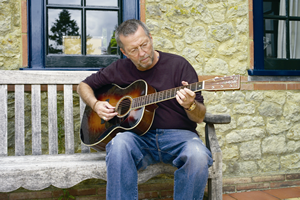
Ask any acoustic guitar player what is one of, if not the, best guitars and chances are he or she will say Martin. For 175 years this fourth-generation, family-owned business in Nazareth, Pennsylvania, has consistently produced superb quality hand-crafted guitars made from the finest imported woods. Performers from blues to bluegrass count on C.F. Martin & Co. to provide them with an instrument that gets better with age. Bluegrass/folk/jazz flatpicking guitarist Tony Rice describes his 1935 D-28 as "a beautiful instrument. I never pick it up but that I don't think that. It's got to be the Holy Grail. It's probably like playing with a Ferrari, right after driving a few Volkswagens."
Company founder Christian Frederick Martin Sr., son of guitar maker and Cabinet Maker Guild member George Martin, apprenticed in Vienna, Austria, with renowned guitar maker Johann Stauffer in 1811. Martin married, had a son, and the family returned to his hometown of Markneukirchen, Germany, where he encountered resistance from the Violin Makers Guild in accepting that a member of the Cabinet Makers Guild could build guitars. A noted wholesaler testified for the cabinet makers that "Christian Frederick Martin, who has studied with the noted violin and guitar maker Stauffer, has produced guitars which in point of quality and appearance leave nothing to be desired and which mark him as a distinguished craftsman." Despite winning the battle, Martin became disillusioned with the restrictive guild system and left Germany on September 9, 1833, for New York City.
In New York, his shop on the Lower West Side sold guitars, cornets, and sheet music in the front room, and contained his guitar production shop in the back. He worked out a distribution agreement with teachers, importers, and wholesalers to sell his guitars beyond his storefront. These early guitars prior to 1840 were co-branded Martin & Schatz and Martin & Coupa. Martin confided to his close friend and business colleague Henry Schatz that he never felt at home in New York and wanted to move. After Martin's wife visited the Schatzes at their 55-acre tract near Nazareth, Pennsylvania, she returned to New York and convinced her husband to relocate to Nazareth. In 1838, C.F. Martin sold his retail store to music dealer Ludecus & Wolter and purchased an eight-acre tract on the outskirts of Nazareth where he spent the rest of his life.
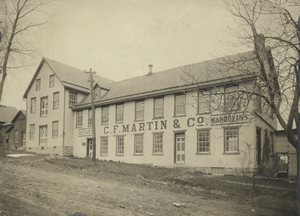
In Nazareth, C.F. Martin & Co. shipped its guitars to Ludecus & Wolter in New York and to the major trade centers, shipping ports, and canal stops of Boston, Albany, Philadelphia, Richmond, Petersburg, Pittsburgh, St. Louis, and Nashville. Satisfactory sales allowed Martin to expand the business, as an 1850 advertisement noted, "The great favor bestowed upon him has induced him to enlarge his factory, in order to supply the increasing demand for his instruments."
Martin handcrafted one-of-a-kind guitars with little standardization but a few commonalities. Until the mid-1840s, C.F. Martin's "Stauffer style" of guitars sported the tuning pegs on one side of the guitar head—a style abandoned for guitars until Leo Fender adopted it for his electric Telecaster in 1948. These early guitars also featured an adjustable neck that Martin ceased using because of its complexity and proclivity for slipping. One 1850s major design innovation still in use today—the "X" bracing—gives the Martin guitar its distinctive brilliant treble and powerful bass tone. The demand for Martin guitars saw the company move its facility from the family homestead to a newly-constructed factory in Nazareth in 1859 employing over a dozen craftsmen.
When C.F. Martin died on February 16, 1873, his son Christian Frederick, Jr. succeeded him as head of the growing company. Weathering good and bad economic times, the company's sales flourished during the Civil War, took a downturn during the Panic of 1873, yet remained stable enough for the business to remain afloat. C.F. Martin, Jr.'s unexpected death in 1888 brought his 22-year-old son, Frank Henry Martin, to the helm of a company facing a severe distribution problem. Only one company in New York, Zoebisch & Sons, handlers of band and orchestral instruments, had the sole distribution rights for Martin guitars. Although the two companies had a long association, Frank Martin believed his guitars suffered from a lack of promotion. The Martin company had also recently expanded into mandolin production to satisfy the demands of recent Italian immigrants, and Zoebisch's reluctance to carry new products thwarted Martin's sales. Frank terminated the distribution agreement and went to direct mail advertisements in local newspapers and his own personal sales trips to music dealers in upper New York state and New England.
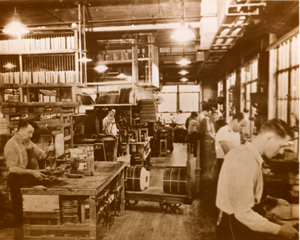
Rather than expand the business, Frank Martin invested money in his two sons' college education. Christian Frederick Martin III, intent on getting away from the family business, found himself back in Nazareth in 1916 after graduating from Princeton University when he realized "my father needed help managing things, so I came home and went to work, making guitars on what I thought would be a part-time basis" that turned into a life-long vocation. Following the successful mandolin sales, the next big breakthrough became the ukulele in the 1920s. When the initially too-heavily-braced ukulele produced a deadened sound and failed to sell, the company retooled and redesigned a lighter-braced model made of mahogany and had to expand the factory and workforce because of the sales demand—manufacturing nearly twice as many ukuleles as guitars.
The Great Depression curtailed expansion and the company struggled to stay in business. They kept workers on a three-day week, reduced the wage rate, and diversified into producing violin parts and wooden jewelry—but only as sidelines until the primary products—guitars, mandolins, and ukuleles—regained their sales footing. C.F. Martin III revealed that "We were always afraid that getting into some other business would hurt our guitar business. We entered a few other fields during the Depression, not with any enthusiasm, but out of necessity."
To stimulate sales during the Depression, the company actively developed new products, two of which had a lasting effect on the company's continued success— the invention of the 14-fret neck and the "Dreadnought" guitar. Developed in late 1929 at the suggestion of a banjoist who believed that the longer neck would increase the guitar's range and versatility, the Orchestra Model's 14-fret neck became the standard design for the American guitar industry. Frank Martin and Harry Hunt, manager of Chas. H. Ditson Co., a music retailer in New York, Boston, and Philadelphia, designed the Dreadnought guitar named after a large class of British battleships. Hunt reasoned that the large body and booming bass would be an ideal instrument to accompany vocalists. Introduced in 1916 under the brand name of "Oliver Ditson & Co., Boston, New York," the Dreadnought at first did not sell well because not many singers used guitars and solo guitarists disliked the overbearing bass. Sales picked up as folk singing became popular. Ditson went out of business in the late 1920s and Martin incorporated the Dreadnought into its line of guitars in 1931. It became a major design in the Martin line and has been copied worldwide by most every other acoustic guitar maker.
Acoustic Guitar magazine readers voted the Martin D-28 "Acoustic Guitar of the Year" gold medal in the 2008 Players' Choice Awards—"the fundamental yardstick for steel-string performance." Contributing Editor Richard Johnston commended it for its versatility—equally comfortable in the hands of Tony Rice as well as Stephen Stills. Songwriter Shawn Colvin told Acoustic Guitar in March 2007 that she still has the first Martin she ever bought, a 1971 D-28, which she retired to play her signature model. One day she played the old guitar and realized "I'd forgotten what a great guitar it is. It kind of plays itself. The new one is great too, but the old one's got some great juju."
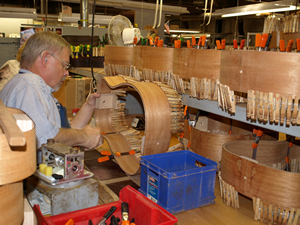
When Frank Henry Martin died in 1948, C.F. Martin III assumed the presidency of the company during an era of unprecedented growth and prosperity after World War II and an accompanying increased interest in acoustic guitar-based folk music. The popularity of the Kingston Trio in the late 1950s and early 1960s sparked interest in acoustic guitars, especially Martins, which two of the three members played. Nick Reynolds, the band's tenor guitarist, "considered Martins real tough workhorses, like the Porsche, they just don't break down." From 1948 to 1970, the demand for Martin guitars outstripped production capacity creating a three-year backlog in orders in the 1960s. C.F. Martin III acknowledged the frustration, "When someone walks into a music store with several hundred dollars and asks for a Martin guitar, he wants it then, not three years later. Our lack of production capacity at the time cost us sales and strained our relationships with our dealer family."
The old multi-story North Street plant in Nazareth could no longer service the demands for the product and C.F. Martin III and his son, Frank Herbert Martin who joined the company in 1955, decided to build a new factory on Sycamore Street with an efficient one-story layout. While retaining the hand-craftsmanship, the new workflow later afforded the company opportunities to mechanize some aspects such as cutting, sanding, and lacquering to relieve workers of repetitive tedium, and increase output while retaining quality.
Frank Herbert Martin, however, took the company off on tangents that distracted from the main purpose—to craft high-quality acoustic guitars. Succeeding his father in 1970, Martin ventured into acquisitions of the Vega Banjo Works, Fibes Drum Company, Darco String Company, and A.B. Herman Carlson Levin Company which made classical and steel-string guitars. In subsequent years, the Martin company sold off all but the string manufacturing business.
The sixth generation owner, C.F. "Chris" Martin IV, joined the company full time in 1978 after graduating from Boston University with a degree in business administration. He worked in several departments to learn how the business functioned before being appointed Vice President of Marketing in 1985, and, upon the death of his grandfather in 1986, Chairman of the Board and Chief Executive Officer. Under Chris Martin's management, the company expanded the Sycamore Street facility, introduced the "1 Series" of redesigned and constructed affordable guitars and the Backpacker travel guitar based on the Strumstick designed by New Jersey luthier Bob McNally, and broadened the limited edition guitar program to include signature models by noted artists like Gene Autry, Eric Clapton, Marty Stuart, and Steve Miller.
In the booklet accompanying the CD, My Favorite Martin, Steve Miller commented that "I've written some of my best songs with my Martin guitars and mysteriously, my Martin collection continues to grow. It goes without saying that I'm very proud to have been personally honored with my own signature model." Don McLean owns over forty Martin guitars. He said that given a choice between winning a Grammy and having his own signature model, he'd "take the Martin any day."
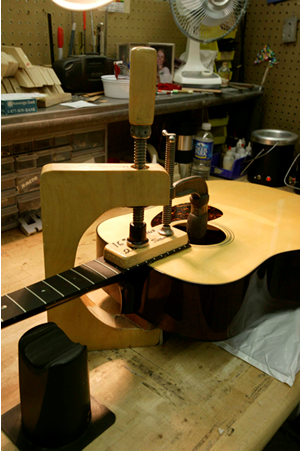
In one of the most poignant stories of the love of a girl and her guitar, Janis Ian recounts on her Web site how she learned to play on her father's secondhand guitar, how it was stolen and missing for years, and the good Samaritan who returned it to her. She recalls, "Artists like Jimi Hendrix would greet me and say 'How's The Guitar doing, man? What a sweetheart!' It was an extraordinary instrument, a 1937 D-18 that somehow, through a combination of wood, break-in, temperature, humidity, and just plain love, wound up being the best acoustic guitar any of them had ever heard. Reverend Gary Davis would beg it at folk festivals; other artists kept offering me money. Why? It had the best bass tone I'd ever heard on a guitar, bar none. And unusual in a guitar from that era, it sounded as good picked as strummed, flat-picked as frailed."
The expanded facility includes a museum, store, and "pickin' parlor" where musicians can play many of the available instruments before they buy. The company offers guided tours of the factory during weekdays.
With his personable style and forward-thinking approach to the business, Chris Martin formalized the company's ecological policy in 1990 by supporting the judicious and responsible use of traditional natural materials and incorporating sustainable-yield, alternative wood species in crafting guitars.
C.F. Martin & Co. celebrated its 175th anniversary in 2008. Among the year-long calendar of celebratory events, the company hosted its third day-long party and open house for Martin Guitar Owners Club members in August. Recognizing the loyalty of Martin guitar owners, Chris Martin thanked attendees for their support and noted that even during the economic downturn, the company remained healthy—a tribute to a family-owned, soundly-run operation that continues to produce one of if not the best acoustic guitars in the world.
Sources:
- Carter, Walter. The Martin Book; A Complete History of Martin Guitars. San Francisco: Backbeat Books, 2006.
- C.F. Martin & Co. 2009. <http://www.martinguitar.com>.
- Gura, Philip F. C.F. Martin and His Guitars, 1796-1873. (H. Eugene and Lillian Youngs Lehman Series). Chapel Hill: University of North Carolina Press, 2003.
- Ian, Janis. "Of Guitars & Righteous Men." Performing Songwriter Magazine Jan. 1999. <http://www.janisian.com/articles-perfsong/guitars-righteousmen.pdf>.
- Johnston, Richard and Dick Boak. Martin Guitars: A History. Revised and updated, Book 1. New York: Hal Leonard Publishing, 2008.
- Johnston, Richard and Dick Boak. Martin Guitars: A Technical Reference. Revised and updated from the original by Mike Longworth, Book 2. New York: Hal Leonard Publishing, 2009.
- Washburn, Jim and Richard Johnston. Martin Guitars: An Illustrated Celebration of America's Premier Guitarmaker. Emmaus, PA: Rodale Press, 1998.
Photos reprinted with permission of Dick Boak, Director of Artist & Public Relations, C.F. Martin & Co. Original photos by Susan Hamburger copyright 2008.
